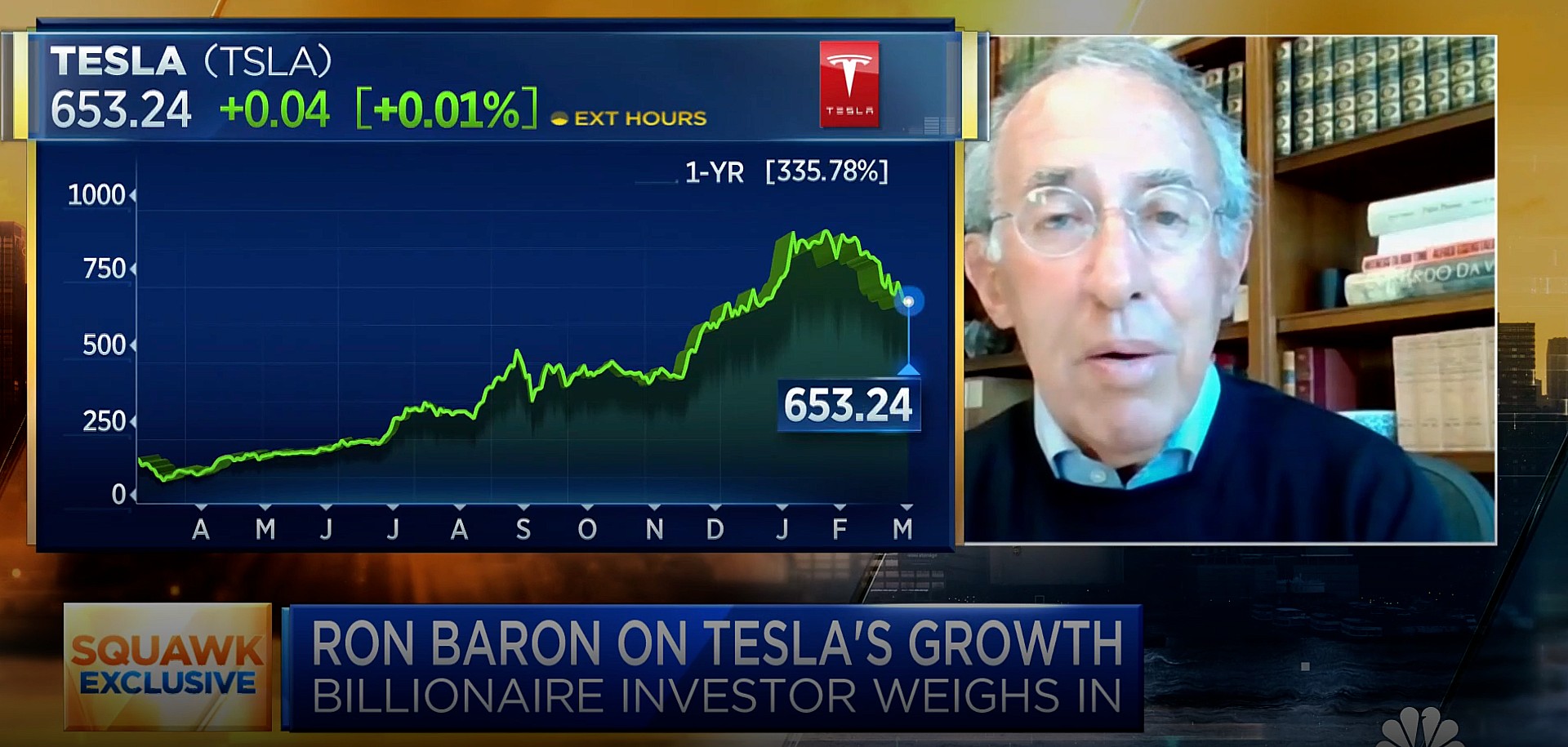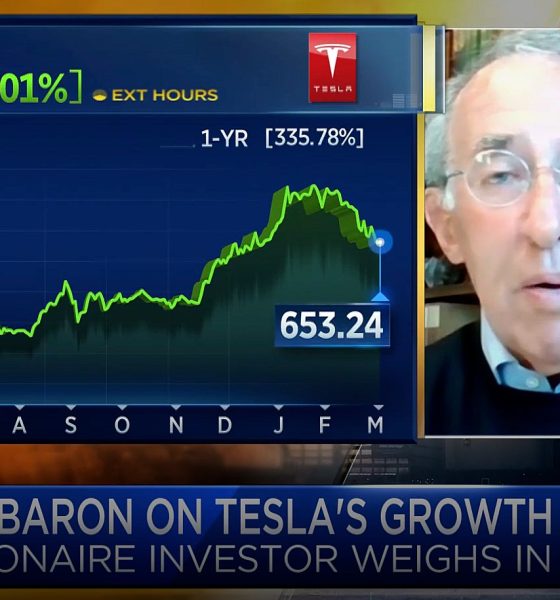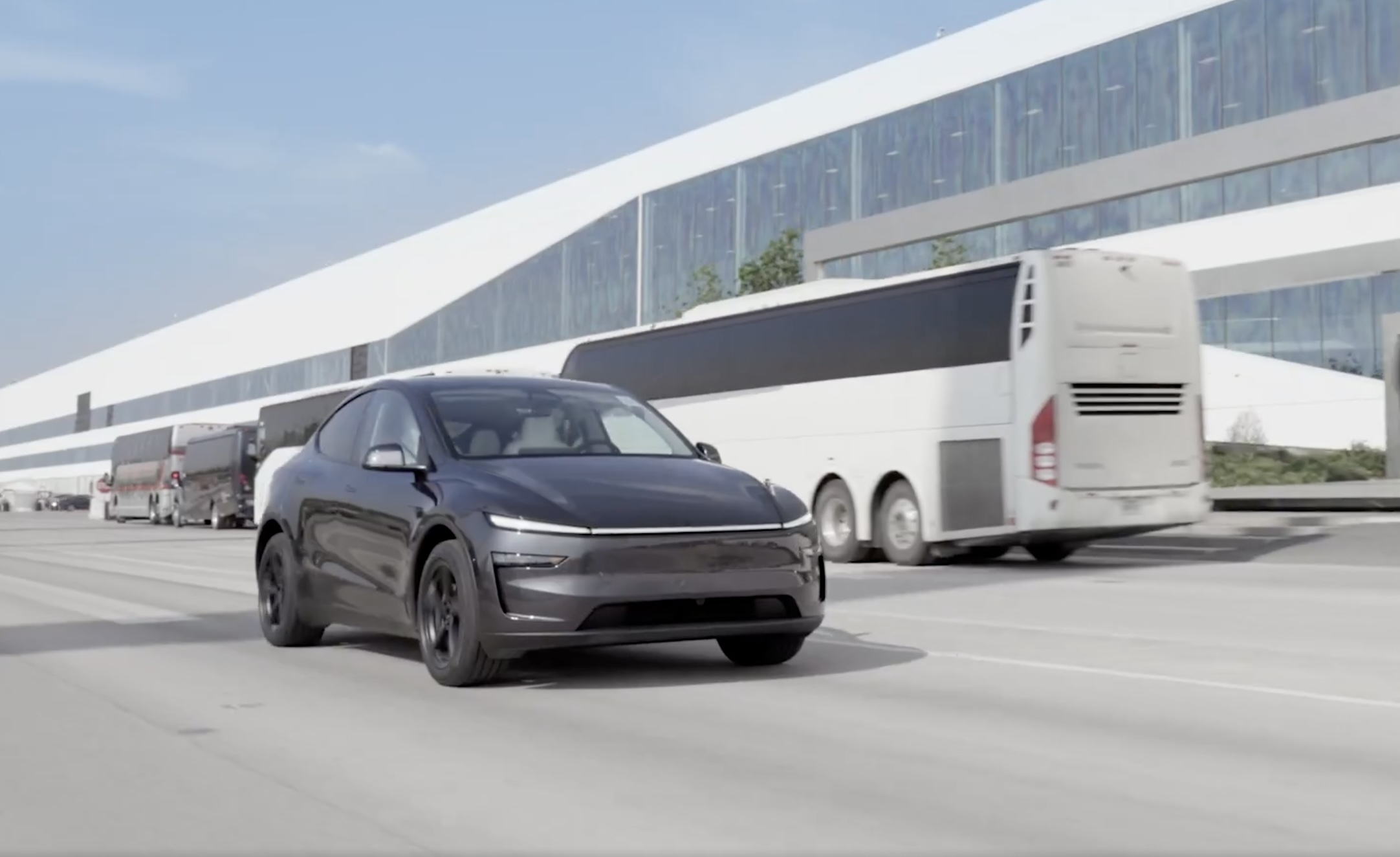

Investor's Corner
Tesla bull Baron Capital sells 1.8M shares, Ron Baron’s personal shares remain untouched
Tesla (NASDAQ: TSLA) bull Ron Baron and his investment firm Baron Capital have been some of the biggest supporters of Elon Musk’s electric car company. Baron Capital, however, has sold 1.8 million TSLA shares over the past six months, Ron Baron said, due to portfolio concentration. The billionaire investor remains bullish on Tesla, revealing that his personal 1.1 million shares haven’t been sold, and none of them will be for at least a decade.
“In the past six months, we have sold about 1.7 million out of our 8 million shares that we held. We sold them between $450 and $900, an average of $666.70. So, we still own 75% of our stock, actually, more than 75%,” Baron told CNBC. Baron still maintains a $2,000 price target per share for ten years in the future, and believes it “could be light by $500 or $1,000.”
Interestingly, if Baron feels that Tesla is still going up, why would his firm decide to sell shares. Ultimately, it comes down to portfolio concentration, and Tesla’s meteoric rise in 2020, which saw the stock price surge over 700%, caused some accounts to become too heavily concentrated in Tesla stock. Portfolio diversity is important, especially for large fund managers, who are investing client’s money based on trust.
Baron Capital made the decision to sell because “it was up 20 times,” Baron said. “It became a very large percentage of some accounts.” Despite Baron Capital’s decision to sell for its clients, Ron Baron stated that his personal ownership stake in Tesla hasn’t budged, and it won’t for at least ten years.
ALSO READ:
Tesla purchases using Bitcoin are coming as EV maker invests $1.5B in cryptocurrency
“I happen to own 1,115,000 shares personally. I haven’t sold a single share, and I don’t expect to for ten years,” Baron added. “But, for clients, I sold 27% or 25% of their stock. I told Elon, ‘I was the last one in, I bought it for all my clients first.’ And in 2016, when I was totally filled on the accounts that I could buy for at our firm, I couldn’t convince other people to buy more, then I invested for in my firm into this company [Tesla], and I think I’m going to hold it for another ten years, at least.”
Baron said that Tesla holdings became more than 50% of two focused funds at Baron Capital and it became a risk management issue. Instead, Baron has invested in several other automotive companies, including Rivian, which is currently still a privately owned company, and Cruise, an autonomous vehicle company that is majority-owned by General Motors. Baron Capital bought more than 1.2 million shares in Janary for $10 million, he said.
While keeping some of the investments behind closed doors, Baron did say that several other EV startups are driving his speculation of the evergrowing market. However, he admits that not all of them will succeed. “If you think all these companies starting up are going to make it, I think it’s a dream. I think it’s astonishing they’re getting so much capital.”
Baron’s interview with CNBC is available below.
Disclosure: Joey Klender is a TSLA Shareholder.

Investor's Corner
Tesla stock lands elusive ‘must own’ status from Wall Street firm

Tesla stock (NASDAQ: TSLA) has landed an elusive “must own” status from Wall Street firm Melius, according to a new note released early this week.
Analyst Rob Wertheimer said Tesla will lead the charge in world-changing tech, given the company’s focus on self-driving, autonomy, and Robotaxi. In a note to investors, Wertheimer said “the world is about to change, dramatically,” because of the advent of self-driving cars.
He looks at the industry and sees many potential players, but the firm says there will only be one true winner:
“Our point is not that Tesla is at risk, it’s that everybody else is.”
The major argument is that autonomy is nearing a tipping point where years of chipping away at the software and data needed to develop a sound, safe, and effective form of autonomous driving technology turn into an avalanche of progress.
Wertheimer believes autonomy is a $7 trillion sector,” and in the coming years, investors will see “hundreds of billions in value shift to Tesla.”
A lot of the major growth has to do with the all-too-common “butts in seats” strategy, as Wertheimer believes that only a fraction of people in the United States have ridden in a self-driving car. In Tesla’s regard, only “tens of thousands” have tried Tesla’s latest Full Self-Driving (Supervised) version, which is v14.
Tesla Full Self-Driving v14.2 – Full Review, the Good and the Bad
When it reaches a widespread rollout and more people are able to experience Tesla Full Self-Driving v14, he believes “it will shock most people.”
Citing things like Tesla’s massive data pool from its vehicles, as well as its shift to end-to-end neural nets in 2021 and 2022, as well as the upcoming AI5 chip, which will be put into a handful of vehicles next year, but will reach a wider rollout in 2027, Melius believes many investors are not aware of the pace of advancement in self-driving.
Tesla’s lead in its self-driving efforts is expanding, Wertheimer says. The company is making strategic choices on everything from hardware to software, manufacturing, and overall vehicle design. He says Tesla has left legacy automakers struggling to keep pace as they still rely on outdated architectures and fragmented supplier systems.
Tesla shares are up over 6 percent at 10:40 a.m. on the East Coast, trading at around $416.
Investor's Corner
Tesla analyst maintains $500 PT, says FSD drives better than humans now
The team also met with Tesla leaders for more than an hour to discuss autonomy, chip development, and upcoming deployment plans.

Tesla (NASDAQ:TSLA) received fresh support from Piper Sandler this week after analysts toured the Fremont Factory and tested the company’s latest Full Self-Driving software. The firm reaffirmed its $500 price target, stating that FSD V14 delivered a notably smooth robotaxi demonstration and may already perform at levels comparable to, if not better than, average human drivers.
The team also met with Tesla leaders for more than an hour to discuss autonomy, chip development, and upcoming deployment plans.
Analysts highlight autonomy progress
During more than 75 minutes of focused discussions, analysts reportedly focused on FSD v14’s updates. Piper Sandler’s team pointed to meaningful strides in perception, object handling, and overall ride smoothness during the robotaxi demo.
The visit also included discussions on updates to Tesla’s in-house chip initiatives, its Optimus program, and the growth of the company’s battery storage business. Analysts noted that Tesla continues refining cost structures and capital expenditure expectations, which are key elements in future margin recovery, as noted in a Yahoo Finance report.
Analyst Alexander Potter noted that “we think FSD is a truly impressive product that is (probably) already better at driving than the average American.” This conclusion was strengthened by what he described as a “flawless robotaxi ride to the hotel.”
Street targets diverge on TSLA
While Piper Sandler stands by its $500 target, it is not the highest estimate on the Street. Wedbush, for one, has a $600 per share price target for TSLA stock.
Other institutions have also weighed in on TSLA stock as of late. HSBC reiterated a Reduce rating with a $131 target, citing a gap between earnings fundamentals and the company’s market value. By contrast, TD Cowen maintained a Buy rating and a $509 target, pointing to strong autonomous driving demonstrations in Austin and the pace of software-driven improvements.
Stifel analysts also lifted their price target for Tesla to $508 per share over the company’s ongoing robotaxi and FSD programs.
Investor's Corner
Tesla wins $508 price target from Stifel as Robotaxi rollout gains speed
The firm cited meaningful progress in Tesla’s robotaxi roadmap, ongoing Full Self-Driving enhancements, and the company’s long-term growth initiatives.

Tesla received another round of bullish analyst updates this week, led by Stifel, raising its price target to $508 from $483 while reaffirming a “Buy” rating. The firm cited meaningful progress in Tesla’s robotaxi roadmap, ongoing Full Self-Driving enhancements, and the company’s long-term growth initiatives.
Robotaxi rollout, FSD updates, and new affordable cars
Stifel expects Tesla’s robotaxi fleet to expand into 8–10 major metropolitan areas by the end of 2025, including Austin, where early deployments without safety drivers are targeted before year-end. Additional markets under evaluation include Nevada, Florida, and Arizona, as noted in an Investing.com report. The firm also highlighted strong early performance for FSD Version 14, with upcoming releases adding new “reasoning capabilities” designed to improve complex decision-making using full 360-degree vision.
Tesla has also taken steps to offset the loss of U.S. EV tax credits by launching the Model Y Standard and Model 3 Standard at $39,990 and $36,990, Stifel noted. Both vehicles deliver more than 300 miles of range and are positioned to sustain demand despite shifting incentives. Stifel raised its EBITDA forecasts to $14.9 billion for 2025 and $19.5 billion for 2026, assigning partial valuation weightings to Tesla’s FSD, robotaxi, and Optimus initiatives.
TD Cowen also places an optimistic price target
TD Cowen reiterated its Buy rating with a $509 price target after a research tour of Giga Texas, citing production scale and operational execution as key strengths. The firm posted its optimistic price target following a recent Mobility Bus tour in Austin. The tour included a visit to Giga Texas, which offered fresh insights into the company’s operations and prospects.
Additional analyst movements include Truist Securities maintaining its Hold rating following shareholder approval of Elon Musk’s compensation plan, viewing the vote as reducing leadership uncertainty.
@teslarati Tesla Full Self-Driving yields for pedestrians while human drivers do not…the future is here! #tesla #teslafsd #fullselfdriving ♬ 2 Little 2 Late – Levi & Mario








